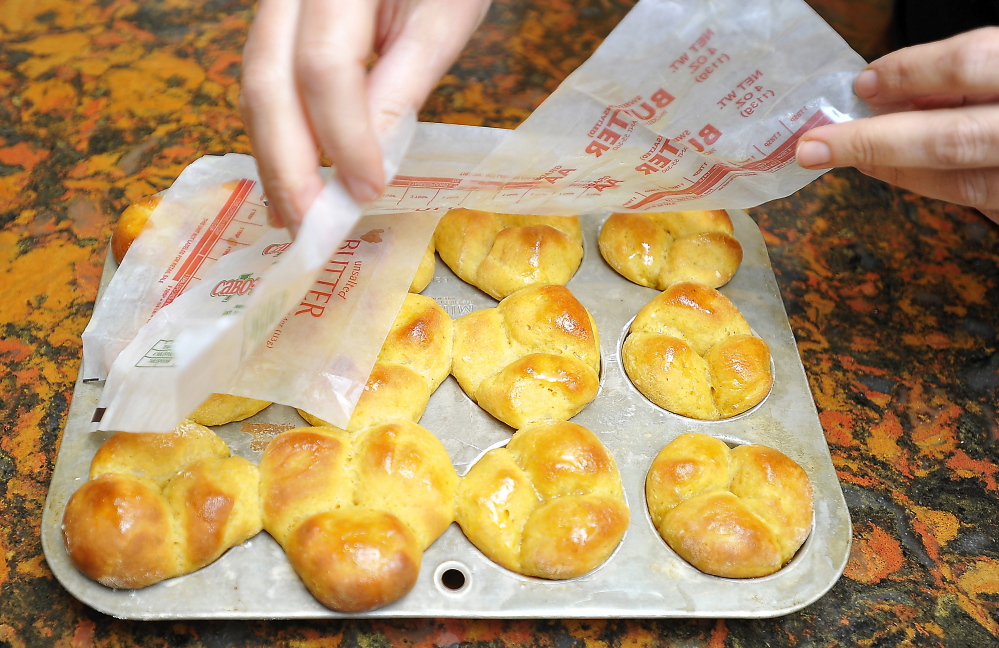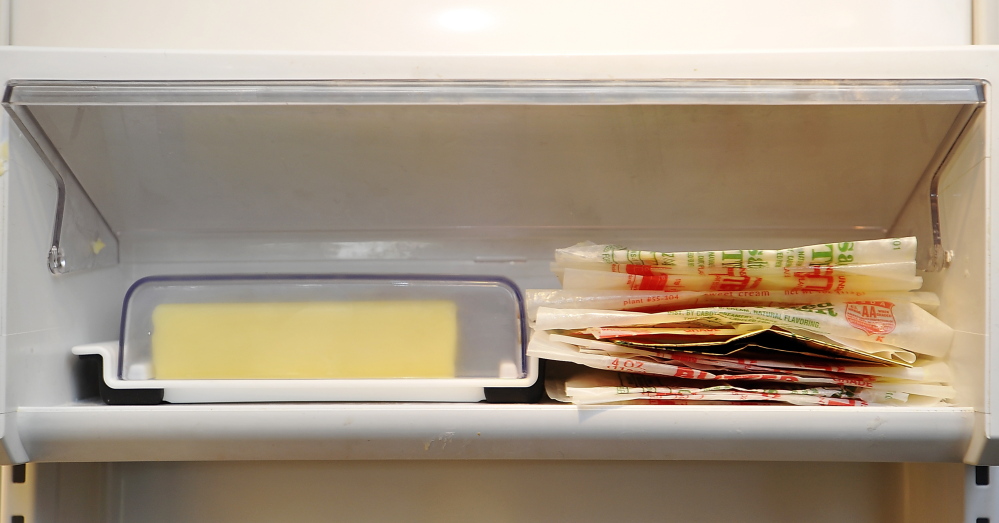The U.S. Department of Agriculture says annual butter consumption in the United States stands at 5.6 pounds per person. Not all butter comes in the four individually wrapped sticks to a pound retail form we see most frequently on grocery store shelves. But, allowing for whole pounds and single serving pats, each of us (at least according to my math) could be reusing 22.4 butter wrappers – and the residual fat contained on them – every year.
Butter first got wrapped with paraffin paper for sale in the 1880s, and the folds for modern butter wrappers were patented by the National Carton Company in 1921. Today, most wrappers are made of grease- and water-resistant vegetable paper. An online debate rages in green circles over whether the wrappers are compostable. But you can’t dispute the merits of reusing them.
If your cake batter calls for a stick of butter, use the wrapper to grease the pan. A frosted cake will slice cleanly if you first grease the knife by running a wrapper along its sides. If you bake yeast breads and dinner rolls and the recipe calls for a final brush of butter, lay a wrapper on top of the freshly baked bread for a moment and let the butter melt in. If toast is the extent of your baking skills, lay a wrapper on top to butter it lightly.
Spent wrappers folded in half – buttery sides facing inwards – and stored in the freezer can be pulled out to lubricate skillets in place of cooking spray, serve as separators for raw hamburger patties and cooked pancakes headed for the freezer, folded into muffin liners, trimmed to double as homemade caramel wrappers, and called into action to help press down sticky Rice Krispies treats or to butter corn on the cob.
If you need to sauté onions slowly without having them pick up any color, lay a wrapper on top of the onions and tuck it gently around them, keep the heat on low and the lid slightly askew, and the onions will soften perfectly. A wrapper placed over just-made butter-based sauces – think Hollandaise or lemon curd – prevents them from developing a skin.
If you’ve stored up a collection of the foil-lined wrappers, use them to wrap potatoes for baking or lay on roasting chickens so they self-baste; I’ve used lots of these ideas myself for decades, others come from no-waste sites on the Internet.
And after you’ve tried all these tricks, don’t throw the wrappers away. Use them under kindling to help light a fire.
NO-KNEAD SWEET POTATO ROLLS
This recipe is adapted from one I found on thekitchn.com.
Makes 24 rolls
1 scant tablespoon (1 package) active-dry yeast
1 cup mashed sweet potatoes
1 cup milk, preferably whole or 2 percent
4 tablespoons (1/2 stick) unsalted butter, melted
2 tablespoons brown sugar
2 teaspoons kosher salt
4 cups all-purpose flour
4 to 8 butter wrappers
Combine 3/4 cup warm water with the yeast in a large mixing bowl and let stand until the yeast is dissolved, about 4 minutes. Add the sweet potatoes, milk, butter, brown sugar and salt. Stir until the ingredients are evenly combined. Add the flour, stirring until a shaggy dough is formed and no dry flour is visible. This dough will be very sticky.
Cover the dough with plastic wrap or a clean kitchen towel and let stand until doubled in bulk, at least 2 hours or as long as 5 hours. The dough can be used immediately, but it’s easier to work with if you can refrigerate it for at least 2 hours. The dough can also be refrigerated for up to 24 hours.
Use butter wrappers to grease two 12-cup muffin tins.
When ready to shape the rolls, sprinkle your work surface with a little flour and turn out the dough. Sprinkle a little more flour on top and press the dough into a thick disk. Use a bench scraper or knife to divide the dough into 72 pieces. Shape into balls. Place three balls in each muffin tin cylinder. Cover and allow to rise until the rolls are roughly doubled in size, about 45 minutes in a warm kitchen.
About 20 minutes before the rolls have finished rising, preheat the oven to 400 degrees F.
Uncover and bake the rolls for 20-25 minutes, until they are puffed and brown. When the rolls are just out of the oven, lay butter wrappers over them for 2 minutes so the butter melts off the paper and glosses the rolls.
The rolls are best the first day, but will stay fresh for several days after if stored in an airtight container.
Christine Burns Rudalevige is a food writer, recipe developer and tester, and cooking teacher in Brunswick. She writes about feeding her family Maine seafood at www.familyfish.net. Contact her at cburns1227@gmail.com.
Send questions/comments to the editors.





Comments are no longer available on this story